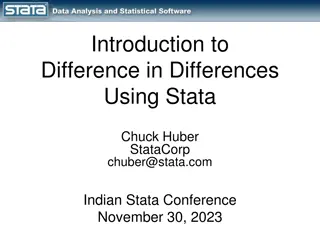
Harnessing the Power of Statistics for Better Business Decisions
Dive into the world of statistics to understand how it shapes the business landscape, empowers decision-making, and drives continuous improvement in product development processes. Discover why statistical skills are crucial for business success in a data-driven era, enabling professionals to make informed decisions, optimize processes, and ensure product quality from the outset.
Download Presentation

Please find below an Image/Link to download the presentation.
The content on the website is provided AS IS for your information and personal use only. It may not be sold, licensed, or shared on other websites without obtaining consent from the author. If you encounter any issues during the download, it is possible that the publisher has removed the file from their server.
You are allowed to download the files provided on this website for personal or commercial use, subject to the condition that they are used lawfully. All files are the property of their respective owners.
The content on the website is provided AS IS for your information and personal use only. It may not be sold, licensed, or shared on other websites without obtaining consent from the author.
E N D
Presentation Transcript
Lecture: Welcome to the world of Statistics. You are probably wondering why should I learn statistics? Statistics helps us make better sense of the world and make better business decisions. For example, by understanding statistics we are able to understand internet article and reports, magazine articles, newspaper articles. Also, we are able to use the data provided to us in business memos, business research, technical journals, and reports to make better business decisions.
In business, statistics has several critical uses. We use statistics to: summarize business data draw conclusions from business data make reliable forecasts about activities improve business processes
Today's good decisions are driven by data. In all aspects of our lives, and importantly in the business context, an amazing diversity of data is available for inspection and Business managers and professionals are increasingly decisions on the basis of data. They need statistical model-based decision support systems. analytical insight. required to justify
Statistical skills enable them to intelligently collect, analyze and interpret data relevant to their decision-making. Statistical concepts and statistical thinking enable them to: solve problems in a diversity of contexts add substance to decisions reduce guesswork
In competitive environment, business managers must design products, and into the processes of making the products. They must facilitate a process of never-ending improvement at all stages of manufacturing and service. This is a strategy that employs statistical methods, particularly statistically designed experiments, and produces processes that provide high yield and products that seldom fail. quality into
Moreover, it facilitates development of robust products that are insensitive to changes in the environment and internal component variation. Carefully planned statistical studies remove hindrances to high quality and productivity at every stage of production. This saves time and money. It is well recognized that quality must be engineered into products as early as possible in the design process. One must know how to use carefully planned, cost-effective experiments to improve, optimize and make robust products and processes. statistical
Business Statistics is a science assisting you to make business decisions under uncertainties based on some numerical and measurable scales. Decision making processes must be based on data, not on personal opinion nor on belief. A course in appreciation of statistical thinking gives business professionals an edge. Professionals with strong quantitative skills are in demand.
To get started in this course, it is important to learn the basic terminology. These include: Statistics is the branch of mathematics that transforms data into useful information for decision makers. Descriptive Statistics is the process ofcollecting, summarizing, presenting and analyzing data. Inferential statistics uses data collected from a small group to draw conclusions about a larger group.
Descriptive Methods are used to create charts and tables, to draw conclusions about business data. We collect data (like in a survey), present data (in tables and charts), and characterize data (by giving the sample mean).
Inferential Methods are used to make reliable forecasts about business activities, to develop, quantify, and improve accuracy of predictive models. For example, we estimate the population mean weight using the same mean weight. Or, we may test the claim that the population mean weight is 180 pounds.
Variables are a characteristics of an item or individual and are what you analyze when you use a statistical method. For example, sales, expenses, and net profile. When used in every day speech, variable suggests that something changes or varies, and you would expect sales, expenses, and net profit to have different value from year to year.
Data are the different values associated with a variable. Data values are meaningless unless their variables have operational definitions, universally accepted meanings that are clear to all associated with an analysis.
Population consists of all the items or individuals about which you want to draw a conclusion. The population is the large group . All registered voters in Ohio is an example of a population. Sample is the portion of a population selected for analysis. The sample is the small group . Using the population of all registered voters in Ohio, you could create a sample of 500 registered voters to survey.
Parameter is a numerical measure that describes a characteristic of a population. The average amount of money spent by all customers at a store this weekend is an example because this amount refers to the amount spent in the entire population. Statistic is a numerical measure that describes a characteristic of a sample. The average amount spent by 30 customers completing the customer satisfaction survey is an example of a statistic.
Before we start looking at graphing, lets review some basic terminology in organizing data. Categorical (qualitative) variables have values that can only be placed into categories, such as yes and no Examples include marital status, political party, eye color (defined categories)
Numerical (quantitative) variables have values that represent quantities. Discrete variables arise from a counting process Examples: number of children or defects per hour Continuous variables arise from a measuring process Examples: weight, voltage
Nominal Scale classifies data into distinct categories in which no ranking is implied. For example, the response to who is your internet provider results in answers that are not ranked in value. They are all equal.
Ordinal Scale classifies data into distinct categories in which ranking is implied. For example: the results to what is your faculty rank could be lecturer, instructor, assistant professor, associate professor, and professor. Or, what is your grade? Each answer has a value that is ranked higher or lower on a scale.
Surveying and Sampling Establishing A Business Objective Focuses Data Collection Examples of Business Objectives: A marketing research analyst needs to assess the effectiveness of a new television advertisement. A pharmaceutical manufacturer needs to determine whether a new drug is more effective than those currently in use.
Examples of Business Objectives: An operations manager wants to monitor a manufacturing process to find out whether the quality of the product being manufactured is conforming to company standards. An auditor wants to review the financial transactions of a company in order to determine whether the company is in compliance with generally accepted accounting principles.
Sources of Data Primary Sources The data collector is the one using the data for analysis Data from a political survey Data collected from an experiment Observed data Secondary Sources The person performing data analysis is not the data collector Analyzing census data Examining data from print journals or data published on the internet.
Data distributed by an organization or an individual A designed experiment A survey An observational study Data collected by ongoing business activities
Examples of Data Distributed By Organizations or Individuals Financial data on a company provided by investment services. Industry or market data from market research firms and trade associations. Stock prices, weather conditions, and sports statistics in daily newspapers.
Examples of Data from a Designed Experiment Consumer testing of different versions of a product to help determine which product should be pursued further. Material testing to determine which supplier s material should be used in a product. Market testing on alternative product promotions to determine which promotion to use more broadly.
Examples of Survey Data Political polls of registered voters during political campaigns. People being surveyed to determine their satisfaction with a recent product or service experience.
Examples of Data Collected from Observational Studies Market researchers utilizing focus groups to elicit unstructured responses to open-ended questions. Measuring the time it takes for customers to be served in a fast food establishment. Measuring the volume of traffic through an intersection to determine if some form of advertising at the intersection is justified.
Examples of Data Collected from Ongoing Business Activities A bank studies years of financial transactions to help them identify patterns of fraud. Economists utilize data on searches done via Google to help forecast future economic conditions. Marketing companies use tracking data to evaluate the effectiveness of a web site.
Data Cleaning is Often a Necessary Activity When Collecting Data Often find irregularities in the data Typographical or data entry errors Values that are impossible or undefined Missing values Outliers When found these irregularities should be reviewed Many statistical software packages will handle irregularities in an automated fashion (Excel does not)
Why Sample? Selecting a sample is less time-consuming than selecting every item in the population (census). An analysis of a sample is less cumbersome and more practical than an analysis of the entire population.
A Sampling Process Begins with a Sampling Frame The sampling frame is a listing of items that make up the population Frames are data sources such as population lists, directories, or maps Inaccurate or biased results can result if a frame excludes certain portions of the population Using different frames to generate data can lead to dissimilar conclusions
Types of Samples In convenience sampling, items are selected based only on the fact that they are easy, inexpensive, or convenient to sample. In a judgment sample, you get the opinions of pre-selected experts in the subject matter. In a simple random, every individual or item from the frame has an equal chance of being selected
Types of Samples Systematic Sample: Decide on sample size, divide into a set number of groups, and randomly select one individual from each group. Stratified Sample: Divide population into two or more subgroups (called strata) according to some common characteristic. Cluster Sample: Population is divided into several clusters, each representative of the population (exit polls after elections).
Types of Survey Error 1) Coverage error or selection bias Exists if some groups are excluded from the frame and have no chance of being selected. If the frame is inadequate because certain groups of items in the population were not properly included, selected will provide only an estimate of the characteristics of the frame, not the actual population. any random sample
Types of Survey Error 2) Non response error or bias People who do not respond may be different from those who do respond You should make several attempts to convince individuals that may typically not complete the survey to complete it. Mode of response should be considered.
Types of Survey Error 3) Sampling error Variation from sample to sample will always exist. Chance indicates some group may always be left out. Example when you read polls you are told the margin of error is +/- 4 percentage points of the actual value. You can reduce sampling error by using larger sample sizes, although doing so increases the cost of doing the survey.
Types of Survey Error 4) Measurement error Due to weaknesses in question design, respondent error, and interviewer s effects on the respondent ( Hawthorne effect ). Occurs when the interviewee feels compelled to please the interviewer.
Ethical Issues Coverage error can result in selection bias and becomes an ethical issue if particular groups are purposely excluded from the frame so that the survey results are more favorable to the survey s sponsor. Non-response error can lead to nonresponse bias and becomes an ethical issue if the sponsor knowingly designs the survey so that particular groups or individuals are less likely than others to respond.
Ethical Issues Sampling error becomes an ethical issue if the findings are purposely presented without reference to the sample size and margin of error so that the sponsor can promote a viewpoint that might otherwise be truly insignificant. Measurement error becomes an ethical issue if the survey sponsors chooses leading questions that guide the responses in a particular direction, an interviewer, through mannerisms and tone, purposely creates the Hawthorne effect or a respondent willfully provides false information.
Illustration of Random Sampling In this exercise we will use random number generation to take a random sample from population. We begin by entering the data into the first column. Suppose this data represents the clients in your company. We have a population of size 26, and we are going to take an individual sample of size 8. Next, we assign random numbers to each individual.
First make sure that the Analysis Tool-Pak add-inn is activated. To do this, select Add-ins.. from the Tools Menu on the menu bar. This will allow us to use a Random Number Generator. Then under Tools, bring up the Data Analysis menu. Select Random Number Generation from the list.
We want 26 random numbers (1 for each unit in our frame), uniform distribution, and we want the output range to be the cells immediately to the right of our data $B2:$B27 . You should put a label in the cell above this range. To select the output range, click on the red arrow to the right of the Output Range text box. This will shrink the dialogue box and allow you to select the appropriate cells. Then press the red arrow again to return to the dialogue.
Then click OK. You ll see the random # s fill in.
Once we have our random numbers, how does this help us take a random sample? If the numbers are random, then if we sort the individuals by these numbers, we should get a random ordering of the individuals. You can now pick the first 8 to get your random sample of 8, which would be B, J, W, V, X, D, K, Q. Those would be the people that you survey. Determine the appropriate sample size was/will be discussed in other lecture notes. In this problem, you will give the sample size.
Another Example: Let s say you wanted to use this same data, but use Excel to randomly pull 8 values from the survey set. Go to Data Analysis Click Sampling Select the input range which is the random numbers. Under Sampling Method, choose Random and select 8. Click Okay
You are then provided with a random sample of 8 numbers from your list of 26 You can then identify the corresponding client letter these numbers are associated with, and that is your survey sample base.
Chapter 1: Class Problems Class Problems 1.12 1.13 1.15 1.26 1.27 1.36 1.37 1.38 1.40 1.42
Class Problems Solutions 1.12 The answer depends on the chosen data set. 1.13 The answer depends on the specific story. 1.15 The transportation engineers and planners should use primary data collected through an observational study of the driving characteristics of drivers over the course of a month.
1.26Before accepting the results of a survey of college students, you might want to know, for example: Who funded the survey? Why was it conducted? What was the population from which the sample was selected? What sampling design was used? What mode of response was used: a personal interview, a telephone interview, or a mail survey? Were interviewers trained? Were survey questions field-tested? What questions were asked? Were they clear, accurate, unbiased, valid? What operational definition of vast majority was used? What was the response rate? What was the sample size?
1.27 a) Possible coverage error: Only employees in a specific division of the company were sampled. b) Possible nonresponse error: No attempt is made to contact non-respondents to urge them to complete the evaluation of job satisfaction. c) Possible sampling error: The sample statistics obtained from the sample will not be equal to the parameters of interest in the population. d) Possible measurement error: Ambiguous wording in questions asked on the questionnaire.






















